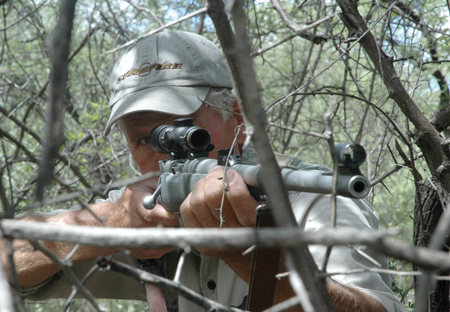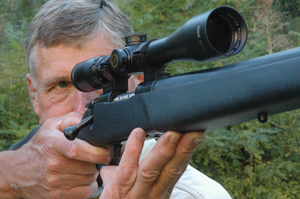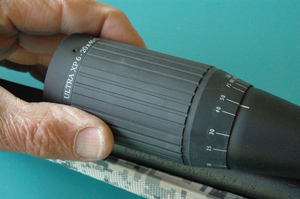 In thickets, you want low magnification. Author has a 1.5-5x Leupold on this Montana rifle. |
The advantages and disadvantages of front- and rear-plane scope reticles are clear. A front-plane reticle grows in apparent size as you dial up the power but stays the same size in relation to the target. It does not move out of the optical center of the scope, and as a range-finding device it gives you the same picture no matter what the magnification. But at long range, where targets appear small and you want precise aim, the reticle can obscure the aiming point.
Up close, when you power down for quick shots in thickets, the reticle shrinks, becoming hard to see quickly. A second-plane reticle stays the same apparent size throughout the power range, so it won’t hide distant targets at high magnification, and it won’t vanish when you turn down the power to find game quickly up close. But because its dimensional relationship to the target changes with every change in magnification, range-finding becomes a task best limited to one power setting.
 Author bears down offhand with a Weatherby Vanguard rifle and Bushnell Elite 6500 scope. |
Shepherd scopes offer both reticles. You get an aiming reticle that doesn’t change size and a range-finding reticle that varies in dimension with power changes. Superimposed, the front- and rear-plane reticles appear as one. The former comprises a stack of circles of decreasing diameter. To determine yardage, match a deer-size (18-inch) target with one of the circles. Correct holdover is factored in because the circles are placed to compensate for bullet drop. A trio of range-finding reticles suit the trajectories of popular cartridges. Vertical and horizontal scales are marked in minutes of angle so you can compensate for wind. The 6-18x M556 Shepherd is specially designed for AR-style rifles. I’ve used these sights; they work as advertised. An amigo has a 6-18x that he says “is really unfair to coyotes.” (Shepherdscopes.com.)
Magnesium is 33 percent lighter than aluminum, so hunters should appreciate Sightron’s SIIIMS line of binoculars. New for 2010, it includes 8×32, 10×32, 8×42 and 10×42 roof-prism, magnesium-frame glasses scaling 20 to 25 ounces. The 8×32 is my choice. All feature phase-corrected, multi-coated optics and twist-up eye-cups. The company is also listing a new ESD – Electronic Sighting Device.
It’s a 33mm red dot sight with a 5-minute dot. Choose from eight intensity levels. Recession got you? Sightron’s S1 scopes are bargain-priced but feature multi-coated front and rear lenses. Pick from a broad selection of reticles, finishes and power ranges. SII and SIII series are up-grades. Like its competition, Sightron is now offering a range-compensating reticle with dots spaced out on the lower wire. Several high-power variables have joined the Sightron family this year. A new SIII Tactical Fixed Power line comprises 10x, 16x, and 20x scopes with 42mm objectives, 30mm tubes.
All told, the 2010 catalog lists more than 50 scopes in SI, SII and SIII series.
Long Range models feature 30mm tubes, turret-mounted parallax dials and reticles that include a mil dot and an illuminated German #4A. Target knobs are tall for easy access. From the 3.5-10×44 to the 8-32×56, these scopes feature fully multi-coated optics in one-piece tubes, with resettable ExacTrack windage and elevation adjustments and a fast-focus eyepiece. External lenses wear “Zact-7,” a seven-layer coating to reduce light loss. A hydrophobic wash disperses raindrops. Eye relief approaches four inches.
An SII 1.25-5×20 Dangerous Game sight with over six inches of clear tube has replaced the 2.5×20 that has served me well on hard-kicking rifles. High-power variables and 36x benchrest sights have front-end parallax sleeves. I like the dot reticle in these scopes, also available on the 5-20×42. Sightron’s Hunter Holdover reticle for hunting scopes incorporates a couple of simple hash marks on the lower wire. Specify it on 3-9×42, 3-12×42 and 45.5-14×42 SIIs, and on the 3-9×40 SI. In my experience, Sightron scopes deliver great value for the dollar. (Sightron.com.)
 Author fitted this Clearidge 6-20×40 AO to a Savage M10 rifle in .308. Low cost. Good optics. |
Aggressively pursuing hunting markets after decades of service to military units the world over, Steiner introduced last year the 21-ounce Wildlife Pro 8×30 binocular, its first center-focus Porro-prism glass in twenty years. For 2010, the firm has announced a laser range-finding binocular. The 10×50 LRF can reportedly range reflective targets to 1,600 yards, and with 1-yard accuracy to 500. The digital display comes up quickly; a scan mode helps you range moving targets. The LRF has HD glass and weighs 46 ounces. Also new from Steiner: 8×56 and 10×56 Predator C5 binoculars. While at 40 and 43 ounces these aren’t as portable as smaller Steiners, they give you brilliant images in poor light.
The 7mm and nearly-6mm exit pupils are all the average eye can use in the deepest shadow. I find these glasses very bright. The newest center-focus versions wear a thin rubber armor for a slim profile. Still the flagship of Steiner’s line is the Peregrine XP. This center-focus, open-bridge binocular focuses as close as 6-1/2 feet. The large 30mm eyepieces have twist-up eyecups and flexible wings that fold back to prevent external fogging from face moisture. Outside lens surfaces feature a hydrophobic “NANO Protection.” It beads water so you can see clearly in rain and snow. The Peregrine XP (8×44 and 10×44) is waterproof and lightweight, with a rugged magnesium frame. It comes with neoprene hood and a clever Click-Loc strap. The Peregrine XP has earned the NRA’s coveted Golden Bullseye Award for excellence. (Steiner-binoculars.com.)
After a decade of vigorous new-product development, Swarovski is tweaking its EL binocular. The Traveler 8×32 and 10×32 are the company’s best hunting binos in casual dress. I like the open-hinge design. Swarovski has expanded its Z6 rifle-scope line to include 2.5-15×56 and 2.5-15×44 sights. They afford you the lowest practical magnification plus enough power to pester prairie dogs in the off-season. I’ve used the 1.7-10×42 afield, have only good things to say about it. The newest Z6 is a 2.5-15×56. As with other 30mm Z6 models, an illuminated reticle is an option. The switch, atop the eyepiece, has an automatic shutoff and two memory locations, one for daytime and one for night use. Turn the switch and the reticle delivers illumination for prevailing conditions. The 1-6×24 Z6 has the broadest power range of any “dangerous game” sight. At 4-3/4 inches, its eye relief is most generous.
Swarovski’s Z5 rifle-scopes offer five-times magnification in one-inch tubes. A 3-15×42 may be the perfect scope for shooters who want the greatest versatility in a relatively lightweight scope. Swarovski borrowed from subsidiary Kahles to produce a Ballistic Turret capable of storing several zero settings. You set those zeroes with ballistics tables or by live firing. Change load and zero; then return to your original in a wink. The Ballistic Turret is an option on selected Swarovski scopes. A simpler way to hit long-range targets is with the BR reticle. Its ladder-type bottom wire has 10 hash-marks. BR is available in three AV models and 1.7-10×42 and 2-12×50 Z6 sights. (Swarovskioptik.com.)
This article is an excerpt from Gun Digest 2011. Click here to get your full copy!







